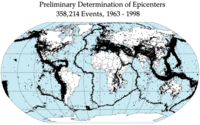
Photo from wikipedia
S U M M A R Y The injection of fluid in the upper crust, notably for the development or exploitation of geothermal reservoirs, is often associated with the onset… Click to show full abstract
S U M M A R Y The injection of fluid in the upper crust, notably for the development or exploitation of geothermal reservoirs, is often associated with the onset of induced seismicity. Although this process has been largely studied, it is not clear how the injected fluid influences the rupture size of the induced events. Here we re-investigate the induced earthquakes that occurred during an injection at Soultz-sous-Forêts, France in 1993 and studied the link between the injected fluid and the source properties of the numerous induced earthquakes. We take advantage that deep borehole accelerometers were running in the vicinity of the injection site. We estimate the moment and radius of all recorded events based on a spectral analysis and classify them into 663 repeating sequences. We show that the events globally obey the typical scaling law between radius and moment. However, at the scale of the asperity, fluctuations of the moment are important while the radii remain similar suggesting a variable stress drop or a mechanism that prevents the growth of the rupture. This is confirmed by linking the event source size to the geomechanical history of the reservoir. In areas where aseismic slip on pre-existing faults has been evidenced, we observed only small rupture sizes whereas in part of the reservoir where seismicity is related to the creation of new fractures, a wider distribution and larger rupture sizes are promoted. Implications for detecting the transition between events related to pre-existing faults and the onset of fresh fractures are discussed.
Journal Title: Geophysical Journal International
Year Published: 2020
Link to full text (if available)
Share on Social Media: Sign Up to like & get
recommendations!